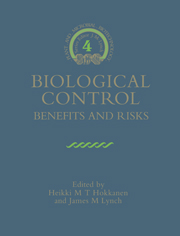Book contents
- Frontmatter
- Contents
- List of Contributors
- Series Preface
- Preface: Overview of Benefits and Risks of Biological Control Introductions
- Part I Biological Invasions
- Part II Classical Biocontrol
- Part III Augmentative Biocontrol
- Part IV Use of Genetically Modified Organisms
- Part V Economics and Registration
- 25 Development of the Biocontrol Fungus Gliocladium virens: Risk Assessment and Approval for Horticultural Use
- 26 Economics of Classical Biological Control: A Research Perspective
- 27 Economics of Biocontrol Agents: An Industrial View
- 28 Registration Requirements of Biological Control Agents in Germany and in the European Union
- Index
27 - Economics of Biocontrol Agents: An Industrial View
Published online by Cambridge University Press: 07 May 2010
- Frontmatter
- Contents
- List of Contributors
- Series Preface
- Preface: Overview of Benefits and Risks of Biological Control Introductions
- Part I Biological Invasions
- Part II Classical Biocontrol
- Part III Augmentative Biocontrol
- Part IV Use of Genetically Modified Organisms
- Part V Economics and Registration
- 25 Development of the Biocontrol Fungus Gliocladium virens: Risk Assessment and Approval for Horticultural Use
- 26 Economics of Classical Biological Control: A Research Perspective
- 27 Economics of Biocontrol Agents: An Industrial View
- 28 Registration Requirements of Biological Control Agents in Germany and in the European Union
- Index
Summary
Introduction
The use of chemical pesticides has resulted in a considerable increase in crop yields throughout the world. There is, however, increasing public pressure against the use of chemical pesticides due to their adverse effects on human health and the environment. The very concept of using chemical pesticides has been challenged by the green movement, which is constantly gaining momentum. World-wide, annual agrochemical sales amount to approximately $US 25 billion (Powell & Jutsum, 1993). Biocontrol agents and biopesticides currently contribute only about 0.5% to the total (Meneley, 1990; Anonymous, 1992). Products based on Bacillus thuringiensis account for 90-95% of biopesticide sales (Feitelson et at., 1992). Bacillus thuringiensis is a biologically produced pesticide, but the active ingredient is not a living organism.
The economics of pesticide use can be considered at three levels: the producer/distributor, the user and society. A pesticide must eventually bring profit for the producer and it must give ample economic return to the user. From society's point of view, the economic benefits from use of a pesticide must clearly offset the adverse effects (Pimentelera/., 1991).
There are scant historical data on the economics of biopesticides other than for Bacillus thuringiensis-based products. Most of the data are proprietary. In this chapter, I discuss the economic aspects of biopesticides from the viewpoint of a company commercializing biopesticides (see Cullen and Whitten, Chapter 26 for a discussion of the economics of biocontrol from a research perspective). The scope is limited to microbial biopesticides. Special emphasis is given to the risks involved in various steps of the development and commercialization process.
- Type
- Chapter
- Information
- Biological ControlBenefits and Risks, pp. 277 - 282Publisher: Cambridge University PressPrint publication year: 1995
- 8
- Cited by

